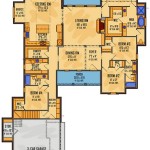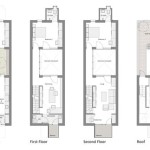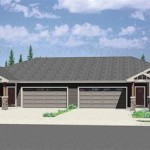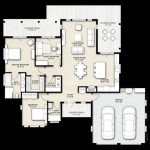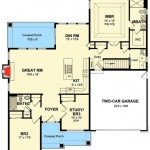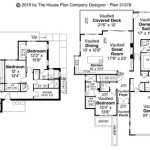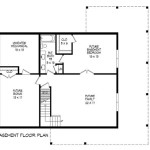Free House Plans With Cost To Build: A Comprehensive Guide
The prospect of building a new home is both exciting and daunting. One of the initial and crucial steps is selecting a house plan that aligns with individual needs, preferences, and budget. While custom architectural designs offer tailored solutions, they can be expensive. Free house plans provide an accessible alternative, but understanding their implications and associated building costs is paramount. This article explores the availability of free house plans, considerations for using them, and how to accurately estimate the cost to build.
The term "free house plans" typically refers to pre-designed architectural drawings offered without an upfront purchase price. These plans are often available online through various sources, including architectural firms, construction companies, and home design websites. While the plans themselves are free to download, they rarely come without caveats. It is crucial to understand the limitations and potential costs associated with using free plans before committing to a building project.
Often, free plans are simplified versions of more detailed, paid plans. They may lack specific construction details, structural engineering calculations, or customization options. They might also be offered as a marketing tool, enticing builders to purchase additional services or materials from the provider. Despite these potential drawbacks, free house plans can be a valuable starting point for homeowners seeking affordable options.
Understanding the Scope of Free House Plans
Examining the documentation provided with free house plans ensures a clear understanding of their scope. Typically, free plans will include basic floor plans, exterior elevations, and potentially rudimentary foundation layouts. What they often lack are detailed construction drawings, electrical plans, plumbing layouts, and HVAC schematics. Moreover, free plans rarely include structural engineering stamps, which are often required for building permits. This means that a structural engineer may need to review and stamp the plans, adding to the overall cost.
Furthermore, free plans are often designed for a specific geographic region and may not comply with local building codes in another area. This can necessitate modifications to the plans, which can incur additional expenses. It is critical to consult with a local building code official or a qualified architect to verify compliance with local regulations before proceeding.
Another factor to consider is the level of detail provided regarding materials and finishes. Free plans may offer general recommendations, but often lack specific information about the quantity, quality, and type of materials needed for construction. This can make it difficult to accurately estimate the overall cost of the project and may lead to unforeseen expenses later on.
Homeowners should carefully review the disclaimers associated with free house plans. These disclaimers often outline the limitations of the plans and absolve the provider of any liability for errors or omissions. It is the homeowner's responsibility to ensure the accuracy and completeness of the plans before submitting them for permits or commencing construction.
Estimating the Cost to Build with Free House Plans
Estimating the cost to build a house using free plans requires a diligent and comprehensive approach. Since free plans typically lack detailed material lists and specifications, developing an accurate cost estimate often involves consulting with building professionals, such as general contractors, subcontractors, and material suppliers.
The cost of building a home is influenced by several key factors, including the size and complexity of the design, the quality of materials used, the labor costs in the local area, and the prevailing market conditions. It is important to factor in all these variables when estimating the total cost of the project.
A crucial step in estimating the cost is to create a detailed bill of materials (BOM). This involves identifying all the materials needed for each phase of construction, from the foundation to the roofing. Because the free plans often lack this level of detail, the homeowner will need to work with a contractor or material supplier to generate a comprehensive BOM.
Labor costs can vary significantly depending on the region and the level of expertise required. Obtaining quotes from multiple contractors and subcontractors is crucial to ensure competitive pricing. It is also important to verify that the contractors are licensed, insured, and have a proven track record of successful projects.
In addition to material and labor costs, homeowners should also factor in other expenses, such as permit fees, engineering fees, site preparation costs, and landscaping expenses. These costs can add up significantly and should not be overlooked when estimating the total cost of the project.
Another effective method for estimating the cost to build is to use online cost calculators or software tools. These tools typically allow users to input the square footage of the house, the type of materials to be used, and the location of the project to generate an estimated cost. However, it is important to note that these tools are only estimates and should not be relied upon as definitive cost figures.
Contingency funds should be included in the budget to account for unforeseen expenses or cost overruns. A general rule of thumb is to allocate at least 10% of the total project cost as a contingency fund. This will provide a buffer to cover unexpected issues that may arise during construction.
Modifying and Adapting Free House Plans
While free house plans can provide a foundation for a new home design, they often require modifications to meet specific needs, preferences, or local building codes. Modifying free plans can range from simple adjustments to significant alterations, depending on the desired outcome.
One common reason for modifying free plans is to accommodate specific site conditions. For example, if the lot has unusual topography or soil conditions, adjustments to the foundation or drainage systems may be necessary. A geotechnical engineer can assess the site conditions and provide recommendations for appropriate modifications.
Another reason for modifying free plans is to incorporate personal preferences or lifestyle requirements. This may involve changing the layout of the rooms, adding or removing walls, or altering the exterior design. An architect or experienced designer can help translate these ideas into detailed plans that meet the homeowner's needs.
Modifications to free plans can also be necessary to comply with local building codes and zoning regulations. These regulations vary from jurisdiction to jurisdiction and can impact various aspects of the design, such as setbacks, height restrictions, and energy efficiency standards. Consulting with a local building code official or architect can ensure that the modifications comply with all applicable regulations.
When modifying free plans, it is crucial to maintain the structural integrity of the design. Any changes to the load-bearing walls, roof structure, or foundation should be carefully reviewed by a structural engineer to ensure that the building remains safe and stable. Failure to do so can have serious consequences.
The cost of modifying free house plans can vary depending on the complexity of the changes. Simple adjustments may only require a few hours of drafting time, while more significant alterations can take several days or weeks. It is important to obtain a detailed quote from the architect or designer before proceeding with the modifications.
In some cases, it may be more cost-effective to start with a custom design rather than trying to modify a free plan. If the required modifications are extensive, the cost of the changes may exceed the cost of a custom design that is tailored to the homeowner's specific needs and site conditions.
Ultimately, the decision to use free house plans and modify them should be based on a careful assessment of the homeowner's needs, budget, and risk tolerance. While free plans can provide a starting point, it is important to understand their limitations and to seek professional guidance when needed.

27 Adorable Free Tiny House Floor Plans Craft Mart

Small House Plans Popular Designs Layouts

27 Adorable Free Tiny House Floor Plans Craft Mart

Free Open Source Strawbale House Design Natural Building Blog

3 Bedroom House Plans Home Designs Nethouseplansnethouseplans

Looking For House Plans Here S Some Free Simple Two Y With Cost To Build Design Layout Plan

Pebble Creek House Plan Archival Designs

2 Room House Plans Low Cost Bedroom Plan Nethouseplansnethouseplans

4 Bedroom House Plan Examples

You Can Use These Affordable House Plans For Free See Inside This Open Source Home By Studiolada

